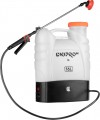Productivity (liquid)
Maximum performance of the sprayer when working with liquid; Please note that in pump (see "Type of pumping") and battery (see "Type") models, the actual performance may decrease as the air supply or battery charge is exhausted.
High performance allows you to quickly process large areas; moreover, it is often combined with a good spraying distance (see below). On the other hand, such models require fairly large tanks — or they often have to be refilled; neither one nor the other contributes to the convenience of work. In addition, over-capacity is even more undesirable than under-capacity: a low-capacity sprayer will just take longer to process, and a too-capacity sprayer can ruin the job by “overdosing” the chemical. Therefore, it makes sense to use high-performance devices only for specific tasks.
Detailed data on optimal performance values for different situations can be found in special sources.
Max. pressure
The maximum operating pressure of the sprayer.
High pressure allows to achieve good spraying performance and range, however, actual performance can vary with units with the same pressure. Therefore, in general, the indicator is for reference (the lion's share of models has a
pressure of 3 bar and
4 bar, and it is only possible to compare different models by it approximately. When choosing, it makes sense to focus on more practical characteristics — performance, range, etc.
Max. fluid temperature
The maximum fluid temperature that the sprayer can safely handle.
The preparation process of some formulations requires heating; therefore, data on the temperature to which the liquid must cool can be very important for safe operation. However, even in the most heat-resistant sprayers, this figure does not exceed 40 °C; such a liquid feels warm to the touch.
It is worth remembering the temperature limits when the unit is in the sun: if the tank has had time to get very hot in the sun, you should let it cool down before starting work.
Hose length
The length of the hose supplied with the sprayer.
The longer the hose, the farther the spray tube can be reached without moving the sprayer itself. However, this is true mainly for wheeled and universal sprayers (see "Carrying type"). In shoulder-mounted units, the hose is usually selected in such a way that it is enough to comfortably hold the tube in your hand, and this parameter in such models most often does not exceed 150 cm.
It is also worth considering that long hoses can be quite bulky; however, this disadvantage is often eliminated by the use of spiral hoses, which are stretched to their full length only when necessary.
Spray wand length
The length of the spray tube supplied with the sprayer.
A long tube, on the one hand, allows you to reach far without leaving your seat and without using stools, ladders, etc.; on the other hand, it is not very manoeuvrable and can be inconvenient when working in tight spaces. When choosing, it is worth proceeding from the optimal compromise between these characteristics. For example, a large tube length (up to 2 m in some models) is useful when processing fruit trees, but for a greenhouse it is better to choose a shorter sprayer. It is also worth considering that some sprayers use telescopic (sliding) tubes, the length of which can be adjusted as needed; in such cases, the unfolded size of the atomizer is usually indicated.
Operating time
Time of continuous operation of the battery sprayer (see "Type") on one battery charge. The actual operating time may differ slightly from the claimed one due to the specifics of a particular situation, however, these differences are usually not very large, and this indicator can be used to evaluate not only theoretical, but also practical indicators of battery life.
Weight
The total weight of the sprayer. Specified without taking into account the liquid or powder in the working tank; at the same time, for battery models (see “Type”), usually, the weight is given with a complete battery, and for gasoline models, on the contrary, “dry” weight, without fuel in the tank.

